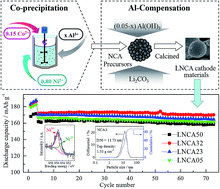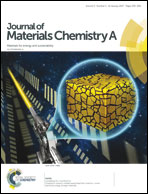A new synthesis strategy towards enhancing the structure and cycle stabilities of the LiNi0.80Co0.15Al0.05O2 cathode material†
Abstract
To enhance the structural stability and electrochemical performances of the LiNi0.80Co0.15Al0.05O2 (LNCA) cathode material for Li-ion batteries, a new synthetic strategy (Al-compensation method) is proposed in this paper. The precursors Ni0.80Co0.15Alx(OH)0.95×2+3x (x ≤ 0.05) are prepared by a hydroxide co-precipitation method, and the final LNCA products are synthesized with the precursors and an additional (0.05 − x) mole ratio of Al(OH)3. This new strategy combines the advantages of co-precipitation and solid state reactions, avoiding the fast precipitation of Al3+ and the flocculent precipitate. As a result, stoichiometric LNCA materials with uniform element distribution are obtained. Compared with LNCA samples prepared by conventional processes, the samples prepared by the Al-compensation method exhibit a better layered structure and hexagonal ordering, lower cation mixing and therefore higher coulombic efficiency and more stable cycle performance. Besides, the influences of calcination temperatures (650, 750 and 850 °C) on the structure and electrochemical performance of LNCA cathodes are investigated in advance, and the reasons for these influences are preliminarily discussed.


 Please wait while we load your content...
Please wait while we load your content...